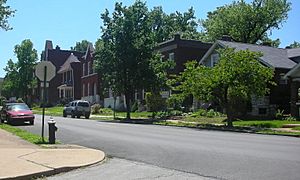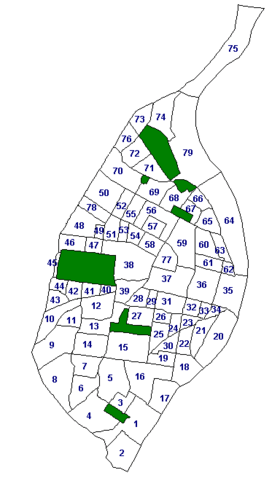Neighborhoods of St facts for kids
St. Louis is a big city in Missouri, and it's split into 79 different areas called neighborhoods. Think of them like smaller towns or communities within the city! For each neighborhood, important information is collected. This includes population counts, crime information, details about old, historic buildings, and even how healthy the food is at local restaurants. Some neighborhoods are also known as "historic" because they have special old buildings and a rich past.
Sometimes, the popular idea of a neighborhood is bigger than its official borders. For example, when people talk about Downtown St. Louis, they often include places like St. Louis Union Station and the Scottrade Center. But officially, Downtown ends a bit sooner. Also, the famous Fox Theatre and Powell Symphony Hall are usually thought of as part of Midtown St. Louis, even though they are technically in Grand Center. And an area called Dogtown, south of Forest Park, actually includes at least four different official neighborhoods!
People also sometimes group several neighborhoods together. For example, they might say "North City" or "South City." North City used to be home to many Polish and German families who moved to St. Louis. You can still see their history in the churches they built, like St. Stanislaus Kostka Church.
Contents
Exploring St. Louis Neighborhoods

Here is a list of all 79 neighborhoods in the city of St. Louis, Missouri. Each one has its own unique feel and history!
| 01 | Carondelet | 21 | Soulard | 41 | Cheltenham | 61 | Carr Square |
| 02 | Patch | 22 | Benton Park | 42 | Clayton/Tamm | 62 | Columbus Square |
| 03 | Holly Hills | 23 | McKinley Heights | 43 | Franz Park | 63 | Old North St. Louis |
| 04 | Boulevard Heights | 24 | Fox Park | 44 | Hi-Pointe | 64 | Near North Riverfront |
| 05 | Bevo Mill | 25 | Tower Grove East | 45 | Wydown/Skinker | 65 | Hyde Park |
| 06 | Princeton Heights | 26 | Compton Heights | 46 | Skinker/DeBaliviere | 66 | College Hill |
| 07 | Southampton | 27 | Shaw | 47 | DeBaliviere Place | 67 | Fairground |
| 08 | St. Louis Hills | 28 | Botanical Heights | 48 | West End | 68 | O'Fallon |
| 09 | Lindenwood Park | 29 | Tiffany | 49 | Visitation Park | 69 | Penrose |
| 10 | Ellendale | 30 | Benton Park West | 50 | Wells/Goodfellow | 70 | Mark Twain/I-70 Industrial |
| 11 | Clifton Heights | 31 | Gate District | 51 | Academy | 71 | Mark Twain |
| 12 | The Hill | 32 | Lafayette Square | 52 | Kingsway West | 72 | Walnut Park East |
| 13 | Southwest Garden | 33 | Peabody/Darst/Webbe | 53 | Fountain Park | 73 | North Point |
| 14 | North Hampton | 34 | LaSalle Park | 54 | Lewis Place | 74 | Baden |
| 15 | Tower Grove South | 35 | Downtown | 55 | Kingsway East | 75 | Riverview |
| 16 | Dutchtown | 36 | Downtown West | 56 | Greater Ville | 76 | Walnut Park West |
| 17 | Mount Pleasant | 37 | Midtown | 57 | The Ville | 77 | Grand Center |
| 18 | Marine Villa | 38 | Central West End | 58 | Vandeventer | 78 | Hamilton Heights |
| 19 | Gravois Park | 39 | Forest Park Southeast | 59
JeffVanderLou |
79 | North Riverfront | |
| 20 | Kosciusko | 40 | Kings Oak | 60 | St. Louis Place |
Who Lives Where? (Demographics)
Demographics is the study of people in an area, like their age, race, or how many people live there. This information helps us understand the different communities in St. Louis. The city is often divided into three main parts:
- North City: This area is north of Delmar Boulevard.
- Central Corridor: This is the middle part, between Delmar Boulevard and Highway I-44.
- South City: This area is south of Highway I-44.
Based on information from the 2010 U.S. Census Bureau:
- In North City, about 94% of people were Black, and about 4% were White.
- In the Central Corridor, about 55% of people were White, and about 35% were Black. About 6% were Asian.
- In South City, about 65% of people were White, and about 26% were Black.
How the City is Governed (Aldermanic Wards)
The city of St. Louis is also divided into areas called wards. Each ward has an Alderman who is a local leader elected by the people living there. These wards change after every new census (which happens every 10 years) to make sure each ward has about the same number of people.
Aldermen are very important for how the city works. If a big project, like building a new park or a large building, is planned in a neighborhood, the local Alderman usually needs to approve it first.
Images for kids





